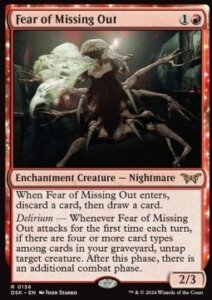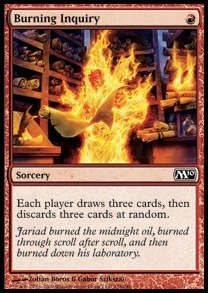If you are new here, don’t forget to check our Discord Channel. It’s free for everyone!
Introduction
Hello, my name is Drake, better known as ChimmyNorbit on Magic Online. I’m a MODO grinder with my favorite format being Modern, and my favorite decks being linear aggressive strategies like Dredge, Prowess, and Hollow One. Since the realease of MH3 I had decent successes with a new Hollow One build, indluding multiple Modern Challenge top 8s. I really like deck’s position right now and I hope I’ll convince you to give it a try.
Hollow One was once a powerhouse in Modern, but after the Faithless Looting ban, the deck has fallen out of favour. However, with the additions from Modern Horizons 3 and Duskmourn, the deck is slowly coming back to being a real player in Modern. What has changed exactly? Is the current Hollow One similar to the old build or did it evolve into something much different compared to the Looting version? And can the deck become a major force in Modern’s metagame? In this article, I’ll try to answer all these questions.
The core of the deck
You can download the decklist in the text form here.
if you can’t see decklists and links, it’s probably becasue you didn’t accept cookies. Doing so is mandatory for the website to work correctly.
First, let’s begin by talking about the core of the deck. The engine of the deck is similar to the older versions of the archetype: Burning Inquiry, Street Wraith, Goblin Lore, and, of course, Hollow One. Burning Inquiry and Goblin Lore are the most unique cards of the deck, but arguably some of the more important pieces as well; they add a level of explosiveness with the deck that not many other decks can keep up with by being able to play as many Hollow Ones as you have in your hand and potentially mess up your opponent’s hand as well. They’re also the best red Delirium enablers available, as they bin multiple cards for the lowest possible mana cost, and to make this deck truly viable, we have to fill our graveyard fast. However, these cards are more on the explosive side than they are on the consistent side – after all, discarding at random can mess things up. How do we fix that?
The key is to play cards that either work from graveyard and hand or become much more powerful when the graveyard is filled with other cards. This is where the new key additions to the deck come into play: Dragon’s Rage Channeler, Nethergoyf, and Detective’s Phoenix. Dragon’s Rage Channeler adds a level of consistency with your draws off Burning Inquiry and Goblin Lore in a way that no other card really can. Being able to turn one Dragon’s Rage Channeler into turn two Burning Inquiry and surveil away either a dead card or keep a relevant threat, such as Hollow One, is something we never had before. Others would argue for Flameblade Adept and Inti, Seneschal of the Sun in the slots of Dragon’s Rage Channeler and Mishra’s Bauble, but in my opinion, those cards are too inconsistent in an already glass cannon style deck to really be worth it.
Nethergoyf is one of the latest additions to the deck, and it is a really good one. For the low cost of one black mana you get what is essentially a Tarmogoyf in our deck. We have 7 types across our deck and it’s not hard at all to get it to be a 5/6 or more on turn 2 when you pair it with Goblin Lore or Burning Inquiry. Nethergoyf keeps ground creatures in check, and is super resilient to non-exile based removal which you can argue makes it better than Tarmogoyf. However, there is some tension between it and the next card that I’ll be mentioning, Detective’s Phoenix, but I think the effort of combining these two cards together is worth it to deal massive amounts of damage that is difficult to block.
Detective’s Phoenix looks, on paper, like garbage. A flying haste 2/2 for 3 mana? That’s barely playable in any recent limited sets, but there is one really big part of this card that makes it a great payoff for this strategy, and that’s its bestow ability. The bestow cost may seem like a lot with you having to collect evidence 6, but in a deck with Hollow One and Street Wraith, that cost is more than achievable. “What if I’m in a heavily-interactive game and my opponent has removal spell after removal spell? Isn’t Bestowing onto a creature just me asking to be 2-for-1’d?” This, unlike other Auras, is not the case. When you bestow onto a creature and it gets removed, you actually get to have the creature half of the card that you’re bestowing with. In these super grindy/interactive matchups where your creatures are getting destroyed constantly, sometimes all you need is a 2/2 flyer to get those last points of damage. Something that I’ve also noticed when talking to other players is that they don’t realise that you can bestow from hand, and not just from your graveyard. Keep this in mind when playing with Detective’s Phoenix to make sure you’re not missing out on extra points of damage.
Next up is Orcish Bowmasters. It’s one of the only individually strong cards in the deck – it doesn’t need graveyard to shine, it’s always solid when played for two mana and can be busted with Burning Inquiry. Bowmasters alone keeps a lot of relevant cards in the format in check: Amped Raptor, Ocelot Pride, and The One Ring to name a few. These cards can be problematic for us since they either clog up the board so we can’t attack, or they stop us from dealing damage completely on our turn. This isn’t the only thing Orcish Bowmasters is used for in our deck, though. When paired with Burning Inquiry, Orcish Bowmasters becomes a powerhouse. Being able to act as a Plague Wind when combined together or just as an extra six damage makes Orcish Bowmasters a terrifying threat and our opponent must have to deal with it or lose the game.
Fear of Missing Out – a new addition to Hollow One or a reason to switch to other Delirium decks?
Hollow One was on the outskirts of Modern after the release of MH3 and no one expected that it would become a major force in the format. But there’s one new card from Duskmourn that can revitalise the whole archetype. Fear of Missing Out, or FOMO for short, is the newest addition to the deck, and what I think is an instant staple to the archetype. This card is what I think makes the deck lean more towards a Delirium deck rather than a Hollow One deck, but still having synergy with our Hollow One roots. The floor of this card is a 2 mana 2/3 that rummages, which can be useful while enabling Delirium or discarding Phoenix that will be used anyway. But since we can fill our graveyard super fast with our core enablers, we take advantage of its second ability almost every time it attacks. When paired with Detective’s Phoenix or an Arena of Glory to give FOMO haste, you’re taking immediate advantage of the extra combat and hopefully dealing lethal, or almost lethal, amounts of damage out of nowhere. In my opinion, this card is a game changer for the deck. Before the printing of this card, Hollow One always felt like it was one turn away from winning, and being able to have an extra combat to hit our opponent with a Nethergoyf or Hollow One twice helps us go from a fringe deck to a real player in today’s Modern.

Some of you would ask if the deck is so hard on the delirium synergies, is it possible to cut the red random discard enablers of the deck and not play Hollow One? What’s the advantage of playing Hollow One over something like Death’s Shadow? The answer isn’t as simple as it might seem at first glance. I think it is possible to cut the random enablers of the deck and run a mono-delirium deck. I also saw versions with Death’s Shadow instead of Hollow One and while there are pros and cons for both, in my opinion, the current version is better suited to execute our main gameplan. The reason for this is that I think the explosiveness of being able to play multiple Hollow Ones in one turn is just impossible to deal with. It’s also worth pointing out that discarding Hollow One was never as beneficial as it is now – a five mana artifact creature is a perfect tool to fuel Phoenix, Nethergoyf, and Delirium. Cycling for two can also mess up the combat out of nowhere. On top of that, Hollow One is immune to some of the most commonly played interactive spells in various decks: Phlage, All is Dust, Kozilek’s Command, Fatal Push, etc.
The timing of our threats can also matter. The Jeskai Control matchup is a good example – the deck relies on Solitude, Leyline Binding, Supreme Verdict, and Prismatic Ending as their main removal spells which decks like Delirium and Death’s Shadow struggle against. The multiple Hollow One opening lines up much better against their removal. If we start with two or more on turn one or two, they’d be forced to evoke Solitude or have a fast Leyline Binding to get rid of one, and hopefully, by the time Supreme Verdict is actually castable, you’ve dealt enough damage to your opponent to get in the final points of damage with Detective’s Phoenix or Orcish Bowmasters. I’m usually pretty happy when my opponent tries to go one for one with my multiple Hollow Ones draw, because that usually means less removal for the real threats of the deck: FOMO, Nethergoyf, and Dragon’s Rage Channeler. On the other hand, it’s hard to cast Death’s Shadow on turn one or two and a single creature later on isn’t something spectacular because of the threat of Supreme Verdict, The One Ring loops, etc.
The last example I will cover is probably the most important and that’s Boros Energy. There are draws from that deck that are unbeatable, sure, but I think the reason I prefer Hollow One in this matchup as compared to mono Delirium or Death Shadow variant is that Hollow One can actually compete with their board reasonably from the get go while setting up our synergies at the same time whereas Death’s Shadow and Delirium style decks usually take the first few turns to set up their game plan without advancing much of their board.
When should you cast Goblin Lore or Burning Inquiry?
This is a question I get asked quite a bit, and it’s often a difficult one to answer. It depends on your hand, and what stage of the game we are in. The only time I go for turn one Burning Inquiry is whenever I have no other plays, and/or I have at least two Hollow Ones in hand to get maximum value out of it. Let’s say we have Nethergoyf or Dragon’s Rage Channeler, Burning Inquiry and a single Hollow One in hand. In this spot, it’s better to play your turn one threat instead, so you can maximise your damage on turn two. The main goal of this deck is to push as much damage as possible as early as possible, so landing an early Nethergoyf, Hollow One, or Dragon’s Rage Channeler is huge for us.

Burning Inquiry is an interesting card as it is symmetrical, which is in general beneficial for us. There is potential for us to absolutely screw over our opponent’s opening hand by making them discard all their relevant spells or lands that they have in hand as early as turn one while we get to play our stuff normally, as we do not care that much about discarding random cards. However, it can be detrimental for us sometimes. With cards like Phlage, Murktide Regent, Past in Flames, Underworld Breach, or anything else that relies on having a graveyard, the risk of casting Burning Inquiry is real. This does lead me to say that if you don’t have a relevant payoff in the form of either growing a Nethergoyf, pinging a bunch with Orcish Bowmasters, or being able to cast multiple Hollow Ones, then you probably shouldn’t cast your Burning Inquiry loosely as relying on top of your deck for potential Hollow Ones or a big Nethergoyf isn’t the best idea.
“Do I play my land or creature before I cast Burning Inquiry or after I cast it?” This is also dependent on what stage of the game we’re in and if you have multiple Hollow Ones in hand. If you have two or more Hollow Ones in hand, I say try and hold off on casting anything before Burning Inquiry as you want to maximise the potential of multiple Hollow Ones in a single turn, and I believe that outweighs the risk of discarding a land or another creature. Otherwise, I’m inclined to play my land and/or creature first, just so you can have a relevant threat on the battlefield and to minimise the potential of being screwed on mana.
There are also times where casting Goblin Lore or Burning Inquiry is correct when it’s the only card in your hand. For example, if you’re in a board stall and you’re trying to push through damage quickly, but the battlefield is clogged up with a bunch of creatures, you should cast it and try to dig for a Detective’s Phoenix to fly over their defences. Another time is if you have multiple Nethergoyfs or Orcish Bowmasters in play and you want to swing the board in your favour or ping your opponent down.
One thing that does come up frequently is when your opponent has two open black mana open, representing a potential Orcish Bowmasters on their side while you have Burning Inquiry or Goblin Lore in hand. If you have an Orcish Bowmasters in your hand, and have the mana available to do this, you should play your Burning Inquiry or Goblin Lore to bait out their Bowmasters, and if they do cast it, you should play your own copy to kill theirs. Doing this causes you to get super far ahead on board and is usually a game winning play for you. If you don’t have Orcish Bowmasters in hand when they have open mana, it’s best to hold onto your draw spells so you don’t get super behind on board. There are rare occasions to go for it, for example when you have multiple Hollow Ones in hand or multiple Nethergoyfs on board, but it’s usually best to not call their bluff and potentially lose the game because of it.
Conclusion
So should you play Hollow One with FOMO? I think the answer is yes! The deck is tons of fun to play and learn and is very different from the rest of the decks in the format. It has a bit of a learning curve at first, but the more experience you have with the deck, the more rewarding it is. The deck isn’t fully developed yet, so there’s a lot to discover. I strongly encourage you to give it a try!
